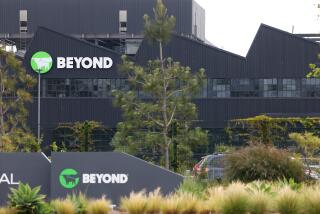Italy: The Last Holdout McGives Up
- Share via
ROME — In a country where a quick lunch is often a two-hour, four-course culinary event, the mere mention of American-style fast food is enough to give indigestion to the traditionalists, even those who indulge in an occasional hurried pizza or barroom sandwich.
Italy, alone among the countries of Europe, has for decades held out against what a critic here called the “gastronomical imperialism” of American fast-food franchises that long ago swept through 14 other countries of the continent, including tiny Andorra.
But the opening last week of the world’s largest McDonald’s, virtually at the foot of the Spanish Steps, marks something of a watershed in a flood of hamburger joints that in just three years has threatened to engulf the last holdout.
Change in Labor Laws
According to Jacques Bahbout, who has the franchise for McDonald’s in Rome, it was not a change in Italian tastes that broke what the newspaper La Repubblica called “the last of the plastic curtains between us and the U.S.A.” It was a change in Italy’s labor laws dealing with low-cost, part-time workers. Until a few years ago, it was illegal to hire hourly help for split shifts at short-order counters, at the noon and evening rush hours when fast food moves fastest.
Now part-time counter help is both legal and economical, Bahbout said, and as a direct result more than 125 U.S.-style fast-food outlets have opened in Italy, mainly in the north, since 1982. Another 40, including two new Wendy’s in Venice and Milan and two more McDonald’s in Rome, are planned by summer. And even more hamburger emporiums are in the works in the coming year, for Naples and points south.
It all began more than three decades ago in San Bernardino, Calif., when brothers Mac and Dick McDonald found success by selling hamburgers and milkshakes in a hurry. Mixing-machine manufacturer and salesman Ray Kroc dropped in one day in 1954, recognized the potential and bought franchise rights from the McDonald brothers. Kroc opened the first McDonald’s in Des Plaines, Ill., in 1955.
The Roman McDonald’s is the 9,007th.
Doing a Booming Business
Despite the Italian passion for dining “with our feet under the table,” as an old expression has it, the fast-food places have been doing a booming business. Desiderio Provera, a top Wendy’s executive in Milan, said his five outlets--one just off graceful St. Mark’s square in Venice and four in Milan--have been averaging more than 1,000 hamburgers each per day at what he called “an average velocity (time per serving) of 15 seconds.”
Giorgio Manfredini, who runs Italy’s latest home-grown hamburger chain, Burghey’s, said “our turnover has doubled every year and we’re still growing.” Burghey’s is distinguished for having the only drive-in hamburger place in Italy, opened last fall on Lake Maggiore, and, since 1982, has established 12 “sales points,” as Manfredini calls them, in Milan, Genoa, Como, Pavia, Bergamo, Novara and Vicenza.
All told, industry sources said the new fast-food outlets had a 1985 turnover of about $50 million. Growth, including a proposed Wendy’s invasion of historic Florence, is expected to be geometric.
Traditional restaurateurs within customer-hailing distance of the new fast-food places say they are not worried.
“The kind of person who would eat a Big Mac with a milkshake is not the kind of person who asks for a table here,” a disdainful waiter said at Nino’s, Rome’s best Tuscan restaurant, which is situated on the Via Borgognona, about 100 yards from the new McDonald’s in the Piazza di Spagna.
Indeed, most of Rome’s new hamburger joints, with names like Big Burg, Benny Burger, Quick and Boburger, appear to have become hangouts and watering holes for young people in their teens and early 20s, a phenomenon that worries some social critics.
‘Death of Italian Cuisine’
“With so many working mothers in Rome, we have a new generation with no place else to go for the meals they used to get at home,” said a disgruntled working mother who still goes home to make a midday family meal. “Most of the mothers have forgotten how to cook, and the new generation of girls isn’t learning. This could be the death of Italian cuisine.”
Provera, the Wendy’s executive, said that he, too, views the Italian family as a problem, but from a different perspective. “Only the kids come to Wendy’s,” he complained. “We can’t call this a success until we get the entire family.”
But with McDonald’s Italian flagship ready to sail in the Piazza di Spagna--already one newspaper is referring to it as “Piazza McSpagna, site of the Spanish McSteps”--Bahbout expects the youth-only image of fast food to change, and he has gone to considerable lengths to assure that the golden arches, at least, will open to plenty of grown-up customers.
For starters, he has remodeled the entryway of an old and somewhat seedy bar-restaurant that he owned in one of the piazza’s most imposing Renaissance buildings. Now it looks like the opening to a chic sidewalk cafe, paved with traditional Rome cobblestones. Unlike many of the franchise chain’s establishments, there is no massive golden arch or flashing boast of how many billions of meat patties have been sold. Instead, there is just a simple “McDonald’s” in soberly lighted typeface.
Fake Roman Stucco Walls
Inside, the sham sidewalk cafe gives way to a lengthy simulated alley, also paved in cobblestone and flanked by fake Roman stucco walls punctuated by false doorways that look like the entryways to neighborhood buildings. The whole entry area is lighted by the same kind of turn-of-the-century street lamps that light the Piazza di Spagna itself.
The alleyway entry ends with a creditable tile copy of an ancient Roman mosaic, then turns up a short flight of steps to get to the real action, a vast room with seating for 450, which Bahbout said tops any of the other McDonald’s in the world. The original ceiling of the Renaissance room, composed of dozens of arched vaults supported by solid brick pillars, add a grace note that must be unique among hamburger joints.
Although young people are expected to be the mainstay of the new fast-food restaurant, Bahbout also expects a more fashionable clientele, the upper-class Italians who shop the elegant stores and boutiques of the nearby Via Condotti and other high fashion streets in the Piazza McSpagna area. To lure them, he has installed a seven-foot grand piano and plans to offer soft music, just short of tea-dance tempo. To attract young mothers, a children’s party room, a fixture in many American McDonald’s, has been set off from the main dining room by green garden railings.
Despite Bahbout’s careful avoidance of the plastic and neon that many Europeans associate with hamburger dining, McDonald’s still must overcome some challenges before it can settle down to becoming truly Roman. For example, the head of the Assn. of Roman Restaurateurs, Giorgio Bodoni, was but one of many to raise a warning flag concerning litter in the famed piazza.
Bahbout responded by hiring extra cleaning crews to sweep periodically through the neighborhood, picking up not only McDonald’s wrappers and containers but general litter as well.
More Serious Challenge
A more serious challenge, perhaps, has come in the form of a letter from the district leader of the Piazza di Spagna area to the mayor of Rome, protesting that Bahbout committed several “irregularities” in remodeling the interior of the building. Rome zoning authorities strictly oversee changes in historic sites, which include most of the city’s buildings, and the Italian Arts Ministry is especially severe when alterations are undertaken “irregularly” without official permission.
But in the Italian way, this charge, which Bahbout denies, will take months and perhaps years to resolve, leaving time, at a velocity of 15 seconds per serving, for the fast-food people to tick off at least another billion served.
More to Read
Eat your way across L.A.
Get our weekly Tasting Notes newsletter for reviews, news and more.
You may occasionally receive promotional content from the Los Angeles Times.










